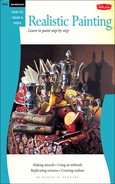SHADOWS AND HIGHLIGHTS
Shadows and highlights add depth, texture, and visual interest to a painting. Make sure to carefully observe objects, their shadows, and their highlights. Consistent shadows and highlights will add credibility to your work. Notice that the closer an object is to a wall or surface on which its shadow falls, the more defined its shadow will be. Highlights also vary depending on the lighting and surface of objects. Use shadows and highlights to capture textures and dramatic contrasts.
SOFT-EDGED SHADOWS
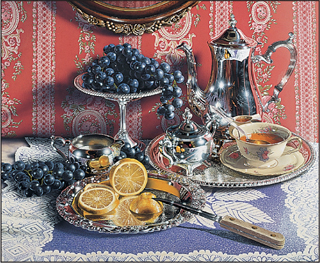
Note the soft, elongated shadows cast from the silver compote. The light is coming from the right, creating a cast shadow on the wall. Remember that shadows are always directly opposite the light source. Use the airbrush to render soft cast shadows.
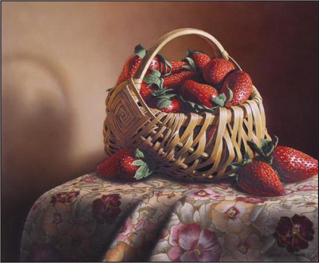
Placing the basket of strawberries further from the wall creates a soft cast shadow on the left background area. The shadow provides a sense of depth and dimension to the painting and contrasts with the hard edges of the basket handle and wicker patterns.

In this painting, the soft background shadow cast by the large jug contrasts with the jug’s hard edges. The shadow helps to isolate the objects in the still life from the background and creates a sense of balance in the composition.
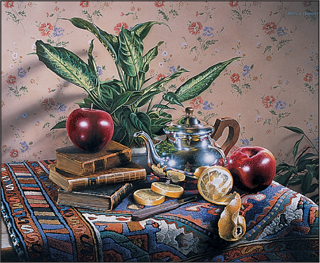
This is a dramatic example of soft-edged shadows cast on a background wall. The plant is struck by light from the right, creating a pattern of shadows on the left wall. The shadows help to add dimension, visual interest, space, and design to the painting.
SHADOWS ON HARD-EDGED OBJECTS
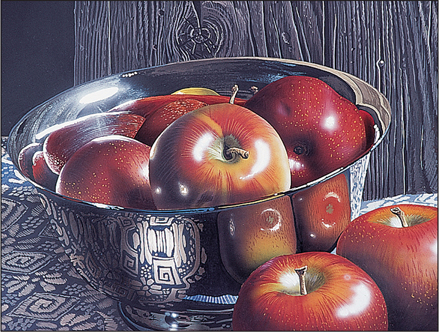
HARD EDGES Each apple in this still life is painted with a separate stencil to achieve crisp, hard edges that reinforce the feel of their slick, shiny skin. The shadows are air-brushed on the left of each piece of fruit. Note that some apples have a subtle highlight in the shadowed edge, which is a result of reflected light.
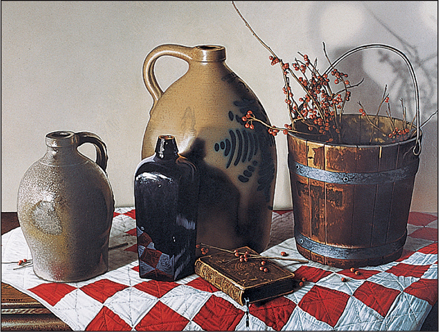
HIGH-CONTRAST LIGHTING In high-contrast lighting, the hard edges of the jugs are rendered with an airbrush and ivory black watercolor. The watercolor glaze allows you to see details within the shadows. Use stencils to create hard-edged shadows. A freehand attempt would make the edges soft and misty.
HIGHLIGHTS

SUBTLE HIGHLIGHTS Although the term “highlight” implies a pure white sparkle, a highlight can also be the brightest area. There are instances in painting when the brightest spots will simply be tints of the colors of the object. Too many pure white highlights can be distracting.
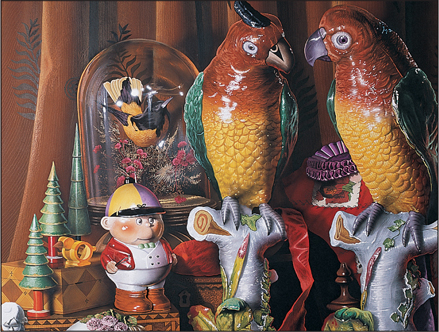
BOLD HIGHLIGHTS There are times, however, when the purest white available will make the highlights “shout” with importance. Here, the highlights on the ceramic are hard and bold, creating the feeling of hard, baked ceramic that is shiny.
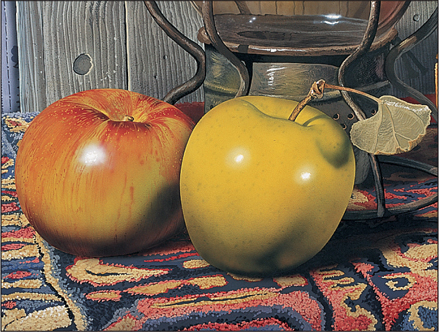
DIFFUSED HIGHLIGHTS At other times, highlights will be diffused, soft, and glowing. With the airbrush, the highlights on the apples are sprayed on with permanent white to create the soft glow of the floodlights on the smooth skins. After the initial highlights are applied, the very center of each glow is highlighted with a small brush and pure permanent white.
